Contemporary Accounting Theory Report: Australian Company Analysis
VerifiedAdded on 2021/02/20
|12
|4133
|265
Report
AI Summary
This report delves into contemporary accounting theory, exploring the history and development of conceptual frameworks for financial reporting, particularly within the context of the International Accounting Standards Board (IASB). It examines the concerns of Australian accounting professionals and academics regarding these frameworks, and illustrates their application through the example of Infigen Energy Limited. The report further compares the Global Reporting Initiative (GRI) and the International Integrated Reporting Framework, highlighting their roles in corporate social responsibility. It discusses the rigor of conventional accounting, the theories used to explain sustainability and integrated reports, and the components of an integrated report, using Montauk Holdings Limited as a case study. Finally, the report contrasts Australian companies' approaches to corporate social responsibility and financial performance reporting, providing a comprehensive overview of contemporary accounting practices and challenges.
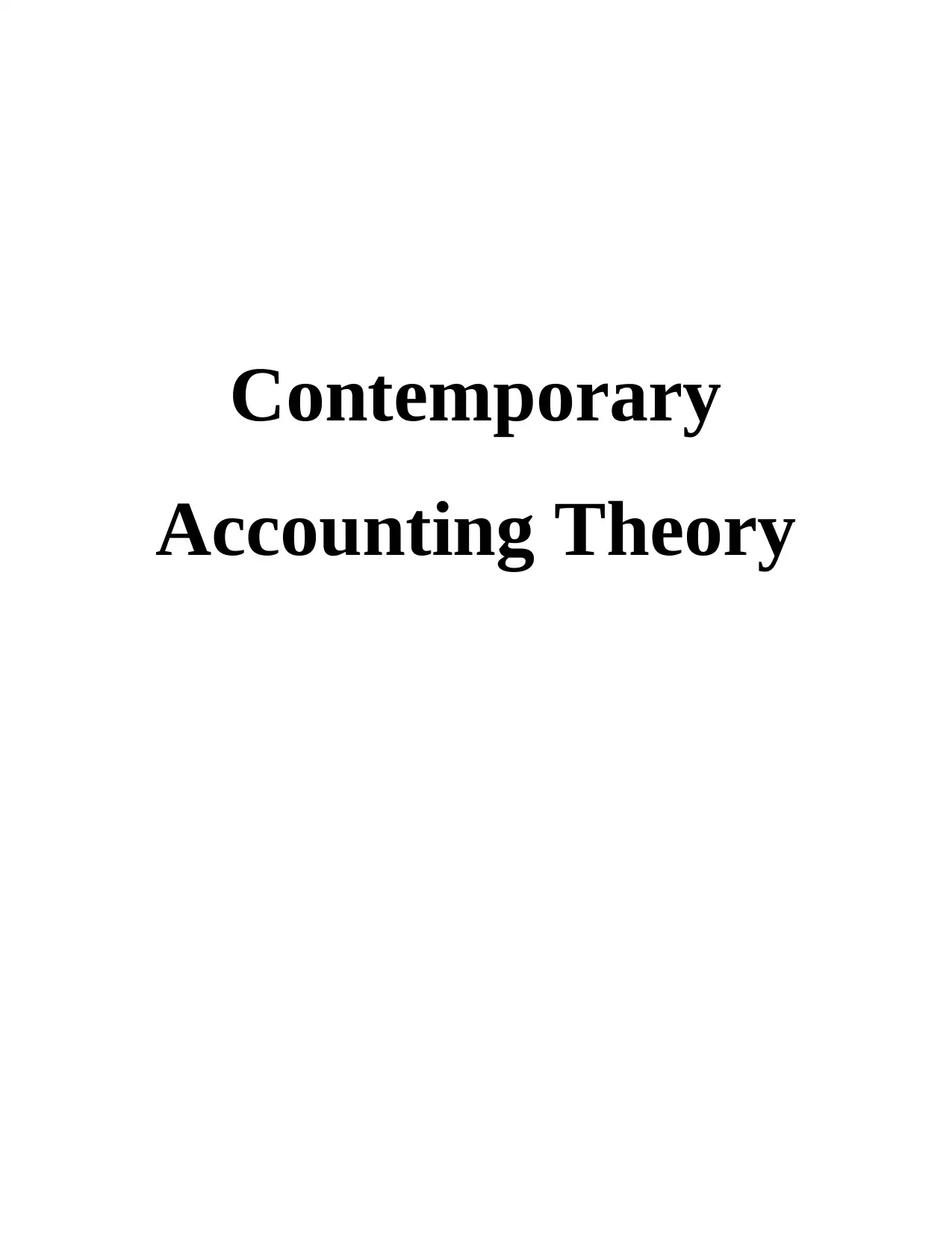
Contemporary
Accounting Theory
Accounting Theory
Paraphrase This Document
Need a fresh take? Get an instant paraphrase of this document with our AI Paraphraser
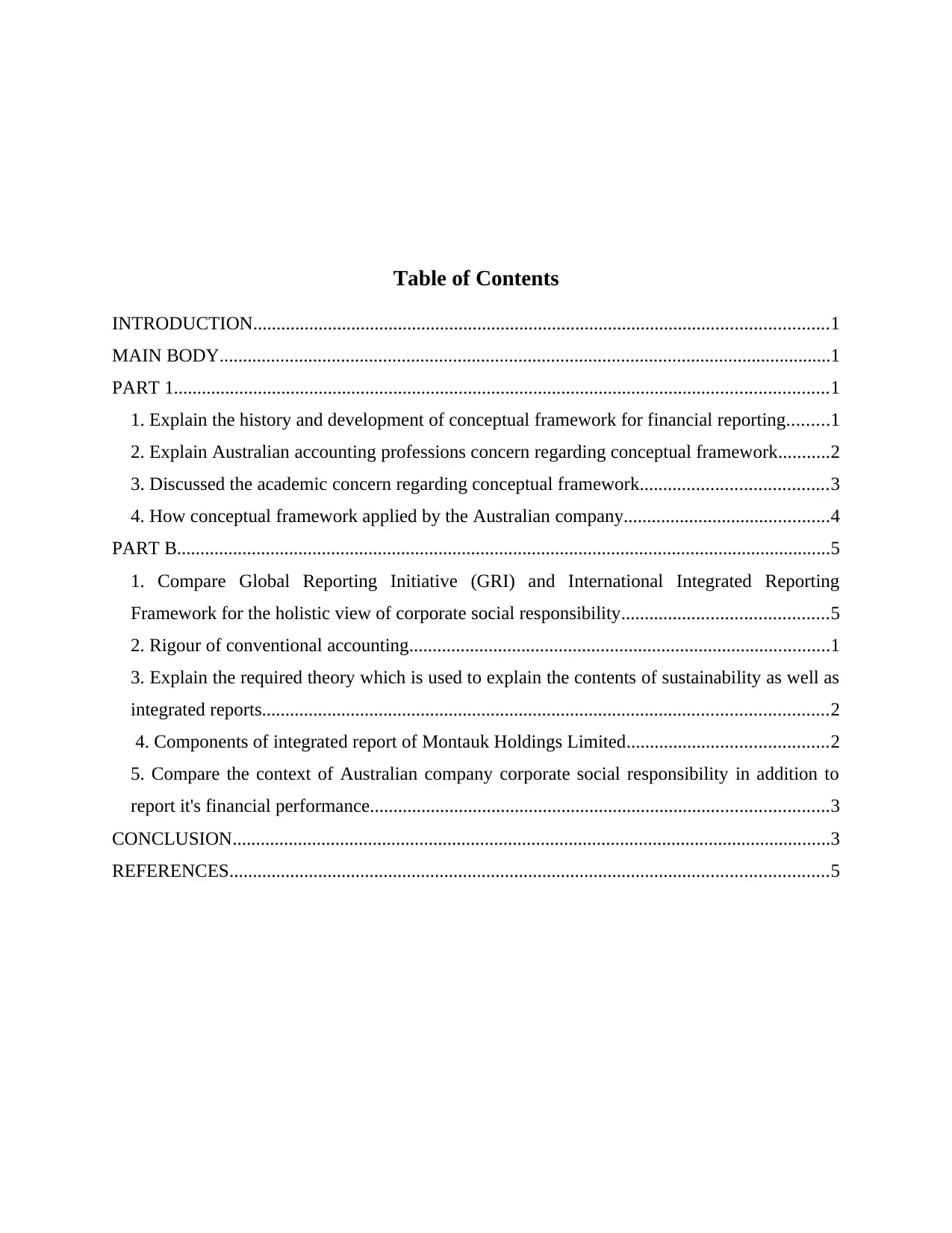
Table of Contents
INTRODUCTION...........................................................................................................................1
MAIN BODY...................................................................................................................................1
PART 1............................................................................................................................................1
1. Explain the history and development of conceptual framework for financial reporting.........1
2. Explain Australian accounting professions concern regarding conceptual framework...........2
3. Discussed the academic concern regarding conceptual framework........................................3
4. How conceptual framework applied by the Australian company............................................4
PART B............................................................................................................................................5
1. Compare Global Reporting Initiative (GRI) and International Integrated Reporting
Framework for the holistic view of corporate social responsibility............................................5
2. Rigour of conventional accounting..........................................................................................1
3. Explain the required theory which is used to explain the contents of sustainability as well as
integrated reports.........................................................................................................................2
4. Components of integrated report of Montauk Holdings Limited...........................................2
5. Compare the context of Australian company corporate social responsibility in addition to
report it's financial performance..................................................................................................3
CONCLUSION................................................................................................................................3
REFERENCES................................................................................................................................5
INTRODUCTION...........................................................................................................................1
MAIN BODY...................................................................................................................................1
PART 1............................................................................................................................................1
1. Explain the history and development of conceptual framework for financial reporting.........1
2. Explain Australian accounting professions concern regarding conceptual framework...........2
3. Discussed the academic concern regarding conceptual framework........................................3
4. How conceptual framework applied by the Australian company............................................4
PART B............................................................................................................................................5
1. Compare Global Reporting Initiative (GRI) and International Integrated Reporting
Framework for the holistic view of corporate social responsibility............................................5
2. Rigour of conventional accounting..........................................................................................1
3. Explain the required theory which is used to explain the contents of sustainability as well as
integrated reports.........................................................................................................................2
4. Components of integrated report of Montauk Holdings Limited...........................................2
5. Compare the context of Australian company corporate social responsibility in addition to
report it's financial performance..................................................................................................3
CONCLUSION................................................................................................................................3
REFERENCES................................................................................................................................5
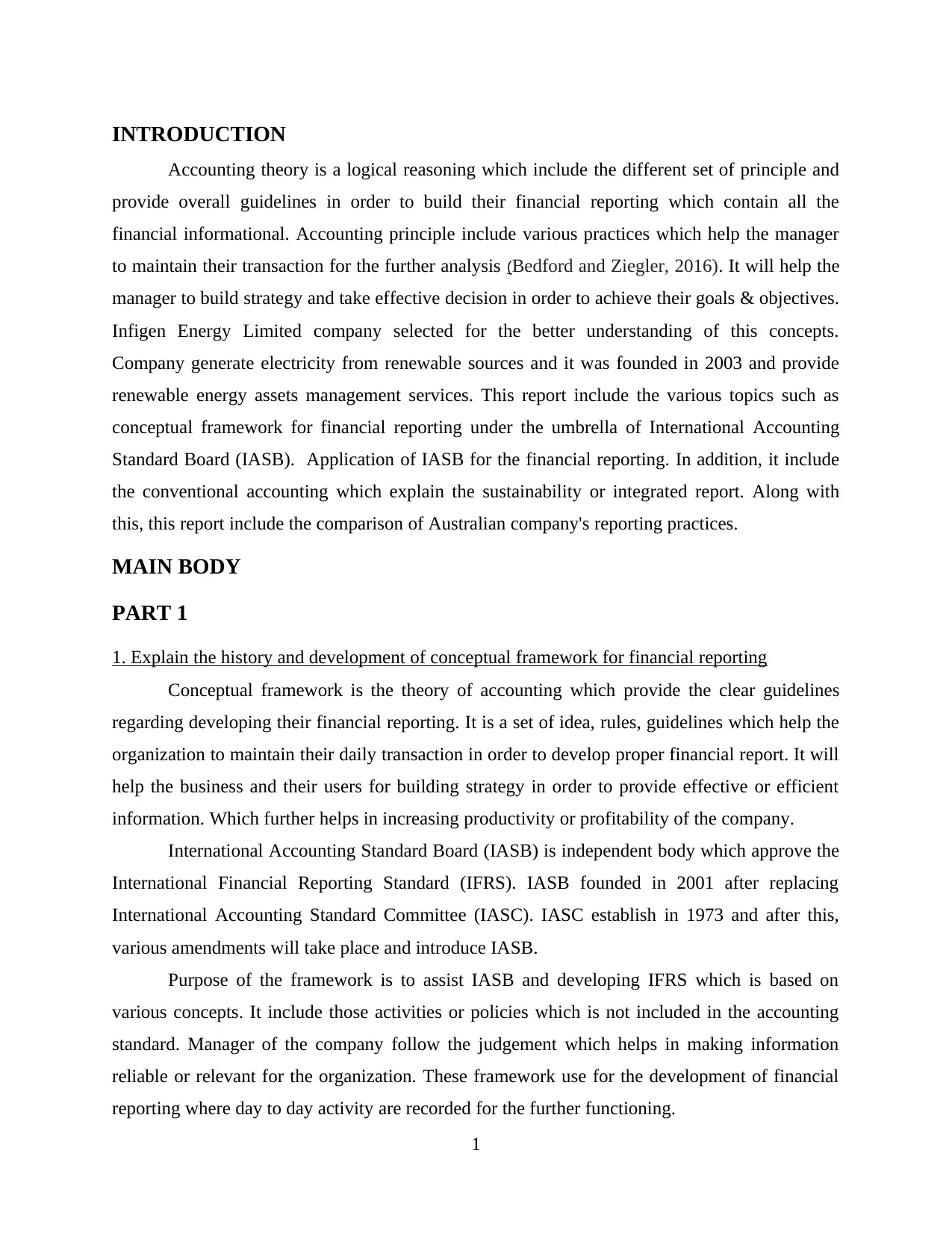
INTRODUCTION
Accounting theory is a logical reasoning which include the different set of principle and
provide overall guidelines in order to build their financial reporting which contain all the
financial informational. Accounting principle include various practices which help the manager
to maintain their transaction for the further analysis (Bedford and Ziegler, 2016). It will help the
manager to build strategy and take effective decision in order to achieve their goals & objectives.
Infigen Energy Limited company selected for the better understanding of this concepts.
Company generate electricity from renewable sources and it was founded in 2003 and provide
renewable energy assets management services. This report include the various topics such as
conceptual framework for financial reporting under the umbrella of International Accounting
Standard Board (IASB). Application of IASB for the financial reporting. In addition, it include
the conventional accounting which explain the sustainability or integrated report. Along with
this, this report include the comparison of Australian company's reporting practices.
MAIN BODY
PART 1
1. Explain the history and development of conceptual framework for financial reporting
Conceptual framework is the theory of accounting which provide the clear guidelines
regarding developing their financial reporting. It is a set of idea, rules, guidelines which help the
organization to maintain their daily transaction in order to develop proper financial report. It will
help the business and their users for building strategy in order to provide effective or efficient
information. Which further helps in increasing productivity or profitability of the company.
International Accounting Standard Board (IASB) is independent body which approve the
International Financial Reporting Standard (IFRS). IASB founded in 2001 after replacing
International Accounting Standard Committee (IASC). IASC establish in 1973 and after this,
various amendments will take place and introduce IASB.
Purpose of the framework is to assist IASB and developing IFRS which is based on
various concepts. It include those activities or policies which is not included in the accounting
standard. Manager of the company follow the judgement which helps in making information
reliable or relevant for the organization. These framework use for the development of financial
reporting where day to day activity are recorded for the further functioning.
1
Accounting theory is a logical reasoning which include the different set of principle and
provide overall guidelines in order to build their financial reporting which contain all the
financial informational. Accounting principle include various practices which help the manager
to maintain their transaction for the further analysis (Bedford and Ziegler, 2016). It will help the
manager to build strategy and take effective decision in order to achieve their goals & objectives.
Infigen Energy Limited company selected for the better understanding of this concepts.
Company generate electricity from renewable sources and it was founded in 2003 and provide
renewable energy assets management services. This report include the various topics such as
conceptual framework for financial reporting under the umbrella of International Accounting
Standard Board (IASB). Application of IASB for the financial reporting. In addition, it include
the conventional accounting which explain the sustainability or integrated report. Along with
this, this report include the comparison of Australian company's reporting practices.
MAIN BODY
PART 1
1. Explain the history and development of conceptual framework for financial reporting
Conceptual framework is the theory of accounting which provide the clear guidelines
regarding developing their financial reporting. It is a set of idea, rules, guidelines which help the
organization to maintain their daily transaction in order to develop proper financial report. It will
help the business and their users for building strategy in order to provide effective or efficient
information. Which further helps in increasing productivity or profitability of the company.
International Accounting Standard Board (IASB) is independent body which approve the
International Financial Reporting Standard (IFRS). IASB founded in 2001 after replacing
International Accounting Standard Committee (IASC). IASC establish in 1973 and after this,
various amendments will take place and introduce IASB.
Purpose of the framework is to assist IASB and developing IFRS which is based on
various concepts. It include those activities or policies which is not included in the accounting
standard. Manager of the company follow the judgement which helps in making information
reliable or relevant for the organization. These framework use for the development of financial
reporting where day to day activity are recorded for the further functioning.
1
⊘ This is a preview!⊘
Do you want full access?
Subscribe today to unlock all pages.

Trusted by 1+ million students worldwide
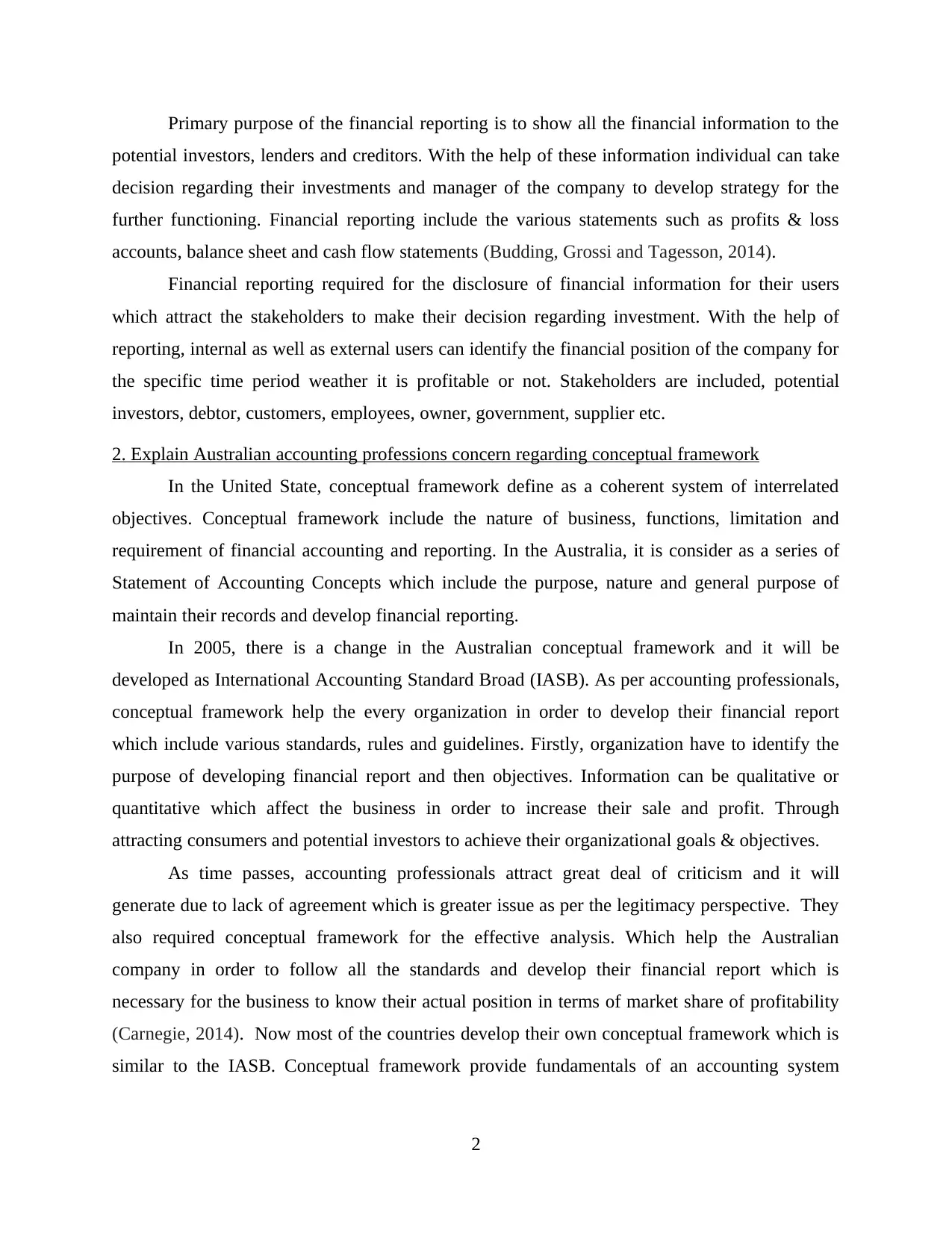
Primary purpose of the financial reporting is to show all the financial information to the
potential investors, lenders and creditors. With the help of these information individual can take
decision regarding their investments and manager of the company to develop strategy for the
further functioning. Financial reporting include the various statements such as profits & loss
accounts, balance sheet and cash flow statements (Budding, Grossi and Tagesson, 2014).
Financial reporting required for the disclosure of financial information for their users
which attract the stakeholders to make their decision regarding investment. With the help of
reporting, internal as well as external users can identify the financial position of the company for
the specific time period weather it is profitable or not. Stakeholders are included, potential
investors, debtor, customers, employees, owner, government, supplier etc.
2. Explain Australian accounting professions concern regarding conceptual framework
In the United State, conceptual framework define as a coherent system of interrelated
objectives. Conceptual framework include the nature of business, functions, limitation and
requirement of financial accounting and reporting. In the Australia, it is consider as a series of
Statement of Accounting Concepts which include the purpose, nature and general purpose of
maintain their records and develop financial reporting.
In 2005, there is a change in the Australian conceptual framework and it will be
developed as International Accounting Standard Broad (IASB). As per accounting professionals,
conceptual framework help the every organization in order to develop their financial report
which include various standards, rules and guidelines. Firstly, organization have to identify the
purpose of developing financial report and then objectives. Information can be qualitative or
quantitative which affect the business in order to increase their sale and profit. Through
attracting consumers and potential investors to achieve their organizational goals & objectives.
As time passes, accounting professionals attract great deal of criticism and it will
generate due to lack of agreement which is greater issue as per the legitimacy perspective. They
also required conceptual framework for the effective analysis. Which help the Australian
company in order to follow all the standards and develop their financial report which is
necessary for the business to know their actual position in terms of market share of profitability
(Carnegie, 2014). Now most of the countries develop their own conceptual framework which is
similar to the IASB. Conceptual framework provide fundamentals of an accounting system
2
potential investors, lenders and creditors. With the help of these information individual can take
decision regarding their investments and manager of the company to develop strategy for the
further functioning. Financial reporting include the various statements such as profits & loss
accounts, balance sheet and cash flow statements (Budding, Grossi and Tagesson, 2014).
Financial reporting required for the disclosure of financial information for their users
which attract the stakeholders to make their decision regarding investment. With the help of
reporting, internal as well as external users can identify the financial position of the company for
the specific time period weather it is profitable or not. Stakeholders are included, potential
investors, debtor, customers, employees, owner, government, supplier etc.
2. Explain Australian accounting professions concern regarding conceptual framework
In the United State, conceptual framework define as a coherent system of interrelated
objectives. Conceptual framework include the nature of business, functions, limitation and
requirement of financial accounting and reporting. In the Australia, it is consider as a series of
Statement of Accounting Concepts which include the purpose, nature and general purpose of
maintain their records and develop financial reporting.
In 2005, there is a change in the Australian conceptual framework and it will be
developed as International Accounting Standard Broad (IASB). As per accounting professionals,
conceptual framework help the every organization in order to develop their financial report
which include various standards, rules and guidelines. Firstly, organization have to identify the
purpose of developing financial report and then objectives. Information can be qualitative or
quantitative which affect the business in order to increase their sale and profit. Through
attracting consumers and potential investors to achieve their organizational goals & objectives.
As time passes, accounting professionals attract great deal of criticism and it will
generate due to lack of agreement which is greater issue as per the legitimacy perspective. They
also required conceptual framework for the effective analysis. Which help the Australian
company in order to follow all the standards and develop their financial report which is
necessary for the business to know their actual position in terms of market share of profitability
(Carnegie, 2014). Now most of the countries develop their own conceptual framework which is
similar to the IASB. Conceptual framework provide fundamentals of an accounting system
2
Paraphrase This Document
Need a fresh take? Get an instant paraphrase of this document with our AI Paraphraser
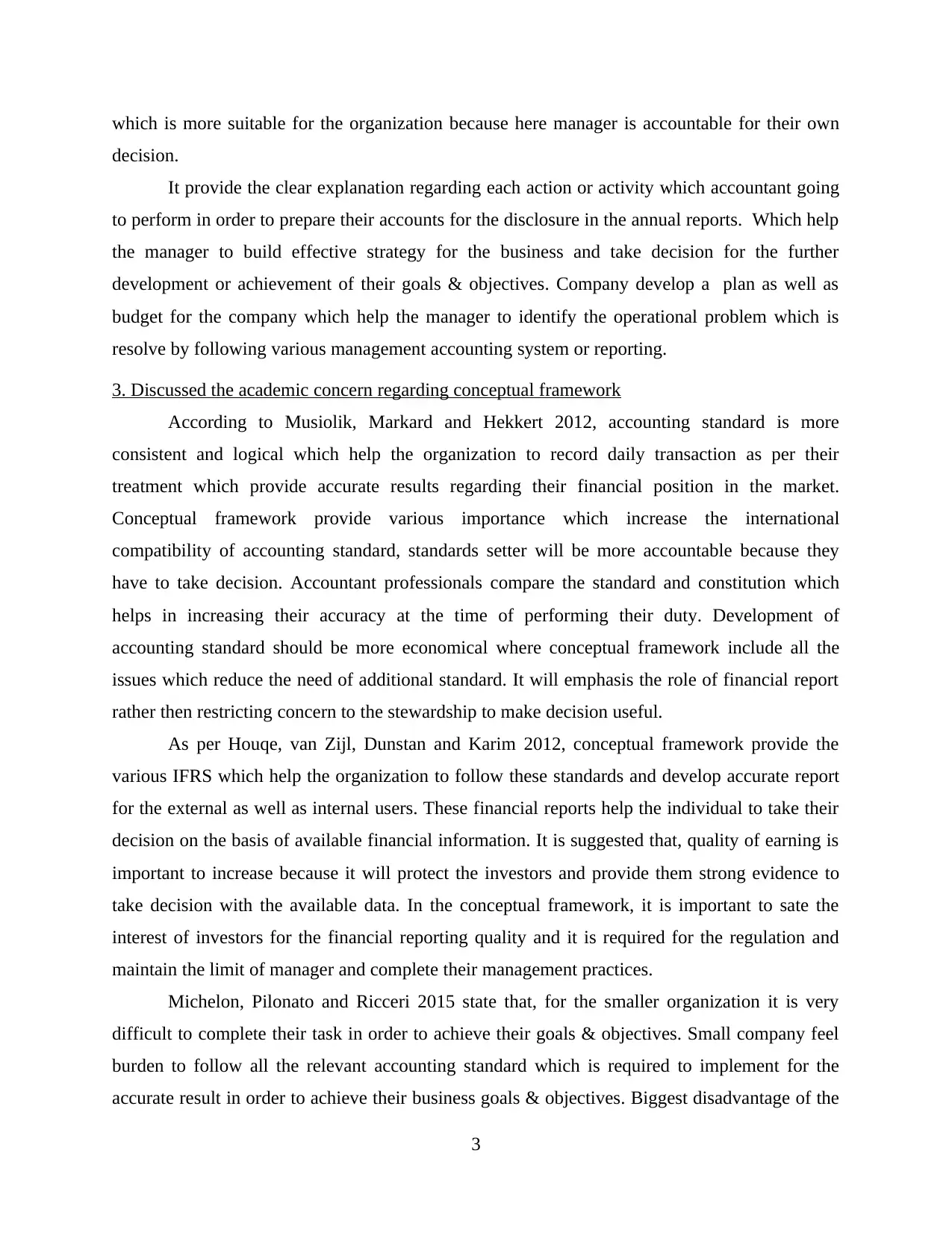
which is more suitable for the organization because here manager is accountable for their own
decision.
It provide the clear explanation regarding each action or activity which accountant going
to perform in order to prepare their accounts for the disclosure in the annual reports. Which help
the manager to build effective strategy for the business and take decision for the further
development or achievement of their goals & objectives. Company develop a plan as well as
budget for the company which help the manager to identify the operational problem which is
resolve by following various management accounting system or reporting.
3. Discussed the academic concern regarding conceptual framework
According to Musiolik, Markard and Hekkert 2012, accounting standard is more
consistent and logical which help the organization to record daily transaction as per their
treatment which provide accurate results regarding their financial position in the market.
Conceptual framework provide various importance which increase the international
compatibility of accounting standard, standards setter will be more accountable because they
have to take decision. Accountant professionals compare the standard and constitution which
helps in increasing their accuracy at the time of performing their duty. Development of
accounting standard should be more economical where conceptual framework include all the
issues which reduce the need of additional standard. It will emphasis the role of financial report
rather then restricting concern to the stewardship to make decision useful.
As per Houqe, van Zijl, Dunstan and Karim 2012, conceptual framework provide the
various IFRS which help the organization to follow these standards and develop accurate report
for the external as well as internal users. These financial reports help the individual to take their
decision on the basis of available financial information. It is suggested that, quality of earning is
important to increase because it will protect the investors and provide them strong evidence to
take decision with the available data. In the conceptual framework, it is important to sate the
interest of investors for the financial reporting quality and it is required for the regulation and
maintain the limit of manager and complete their management practices.
Michelon, Pilonato and Ricceri 2015 state that, for the smaller organization it is very
difficult to complete their task in order to achieve their goals & objectives. Small company feel
burden to follow all the relevant accounting standard which is required to implement for the
accurate result in order to achieve their business goals & objectives. Biggest disadvantage of the
3
decision.
It provide the clear explanation regarding each action or activity which accountant going
to perform in order to prepare their accounts for the disclosure in the annual reports. Which help
the manager to build effective strategy for the business and take decision for the further
development or achievement of their goals & objectives. Company develop a plan as well as
budget for the company which help the manager to identify the operational problem which is
resolve by following various management accounting system or reporting.
3. Discussed the academic concern regarding conceptual framework
According to Musiolik, Markard and Hekkert 2012, accounting standard is more
consistent and logical which help the organization to record daily transaction as per their
treatment which provide accurate results regarding their financial position in the market.
Conceptual framework provide various importance which increase the international
compatibility of accounting standard, standards setter will be more accountable because they
have to take decision. Accountant professionals compare the standard and constitution which
helps in increasing their accuracy at the time of performing their duty. Development of
accounting standard should be more economical where conceptual framework include all the
issues which reduce the need of additional standard. It will emphasis the role of financial report
rather then restricting concern to the stewardship to make decision useful.
As per Houqe, van Zijl, Dunstan and Karim 2012, conceptual framework provide the
various IFRS which help the organization to follow these standards and develop accurate report
for the external as well as internal users. These financial reports help the individual to take their
decision on the basis of available financial information. It is suggested that, quality of earning is
important to increase because it will protect the investors and provide them strong evidence to
take decision with the available data. In the conceptual framework, it is important to sate the
interest of investors for the financial reporting quality and it is required for the regulation and
maintain the limit of manager and complete their management practices.
Michelon, Pilonato and Ricceri 2015 state that, for the smaller organization it is very
difficult to complete their task in order to achieve their goals & objectives. Small company feel
burden to follow all the relevant accounting standard which is required to implement for the
accurate result in order to achieve their business goals & objectives. Biggest disadvantage of the
3
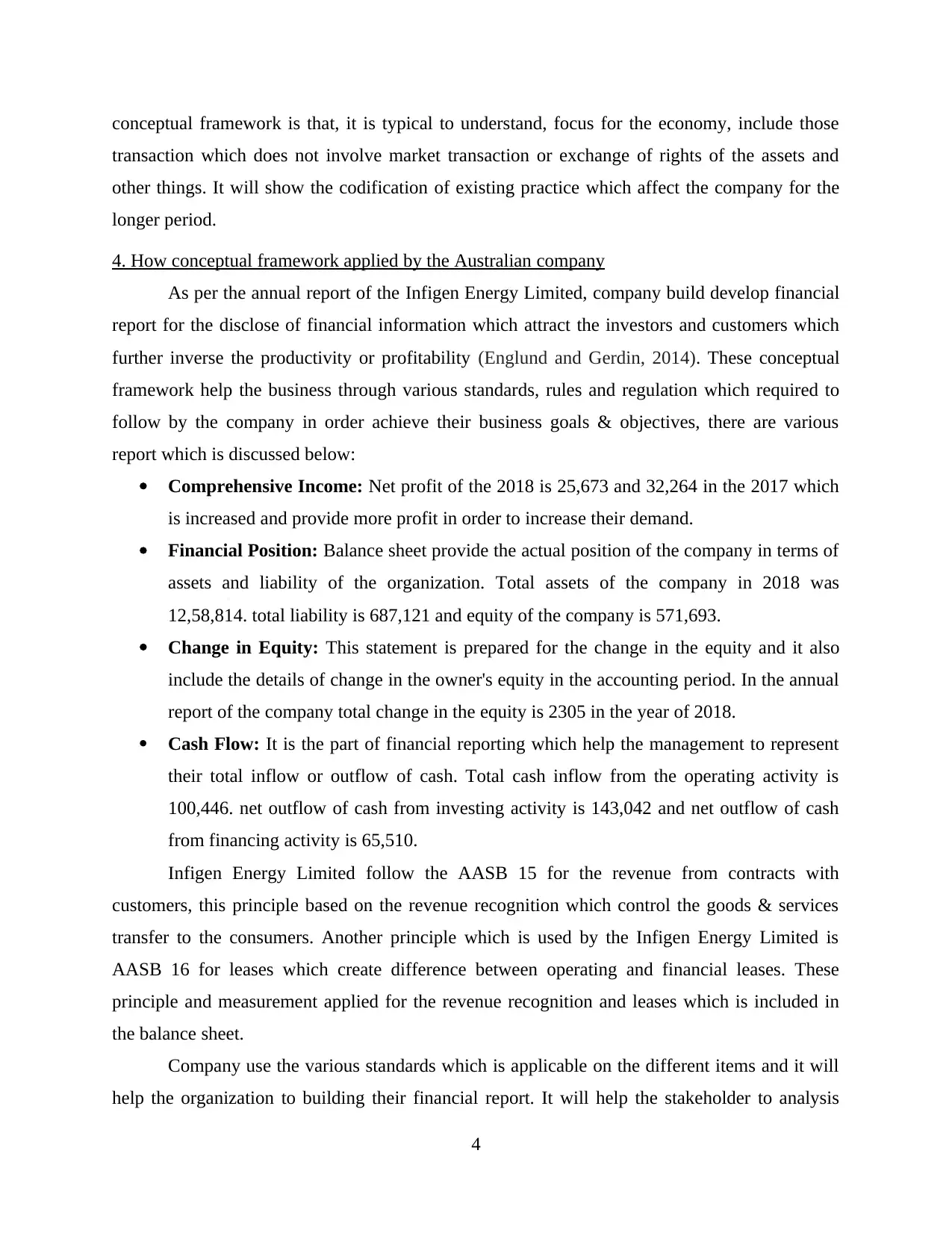
conceptual framework is that, it is typical to understand, focus for the economy, include those
transaction which does not involve market transaction or exchange of rights of the assets and
other things. It will show the codification of existing practice which affect the company for the
longer period.
4. How conceptual framework applied by the Australian company
As per the annual report of the Infigen Energy Limited, company build develop financial
report for the disclose of financial information which attract the investors and customers which
further inverse the productivity or profitability (Englund and Gerdin, 2014). These conceptual
framework help the business through various standards, rules and regulation which required to
follow by the company in order achieve their business goals & objectives, there are various
report which is discussed below:
Comprehensive Income: Net profit of the 2018 is 25,673 and 32,264 in the 2017 which
is increased and provide more profit in order to increase their demand.
Financial Position: Balance sheet provide the actual position of the company in terms of
assets and liability of the organization. Total assets of the company in 2018 was
12,58,814. total liability is 687,121 and equity of the company is 571,693.
Change in Equity: This statement is prepared for the change in the equity and it also
include the details of change in the owner's equity in the accounting period. In the annual
report of the company total change in the equity is 2305 in the year of 2018.
Cash Flow: It is the part of financial reporting which help the management to represent
their total inflow or outflow of cash. Total cash inflow from the operating activity is
100,446. net outflow of cash from investing activity is 143,042 and net outflow of cash
from financing activity is 65,510.
Infigen Energy Limited follow the AASB 15 for the revenue from contracts with
customers, this principle based on the revenue recognition which control the goods & services
transfer to the consumers. Another principle which is used by the Infigen Energy Limited is
AASB 16 for leases which create difference between operating and financial leases. These
principle and measurement applied for the revenue recognition and leases which is included in
the balance sheet.
Company use the various standards which is applicable on the different items and it will
help the organization to building their financial report. It will help the stakeholder to analysis
4
transaction which does not involve market transaction or exchange of rights of the assets and
other things. It will show the codification of existing practice which affect the company for the
longer period.
4. How conceptual framework applied by the Australian company
As per the annual report of the Infigen Energy Limited, company build develop financial
report for the disclose of financial information which attract the investors and customers which
further inverse the productivity or profitability (Englund and Gerdin, 2014). These conceptual
framework help the business through various standards, rules and regulation which required to
follow by the company in order achieve their business goals & objectives, there are various
report which is discussed below:
Comprehensive Income: Net profit of the 2018 is 25,673 and 32,264 in the 2017 which
is increased and provide more profit in order to increase their demand.
Financial Position: Balance sheet provide the actual position of the company in terms of
assets and liability of the organization. Total assets of the company in 2018 was
12,58,814. total liability is 687,121 and equity of the company is 571,693.
Change in Equity: This statement is prepared for the change in the equity and it also
include the details of change in the owner's equity in the accounting period. In the annual
report of the company total change in the equity is 2305 in the year of 2018.
Cash Flow: It is the part of financial reporting which help the management to represent
their total inflow or outflow of cash. Total cash inflow from the operating activity is
100,446. net outflow of cash from investing activity is 143,042 and net outflow of cash
from financing activity is 65,510.
Infigen Energy Limited follow the AASB 15 for the revenue from contracts with
customers, this principle based on the revenue recognition which control the goods & services
transfer to the consumers. Another principle which is used by the Infigen Energy Limited is
AASB 16 for leases which create difference between operating and financial leases. These
principle and measurement applied for the revenue recognition and leases which is included in
the balance sheet.
Company use the various standards which is applicable on the different items and it will
help the organization to building their financial report. It will help the stakeholder to analysis
4
⊘ This is a preview!⊘
Do you want full access?
Subscribe today to unlock all pages.

Trusted by 1+ million students worldwide
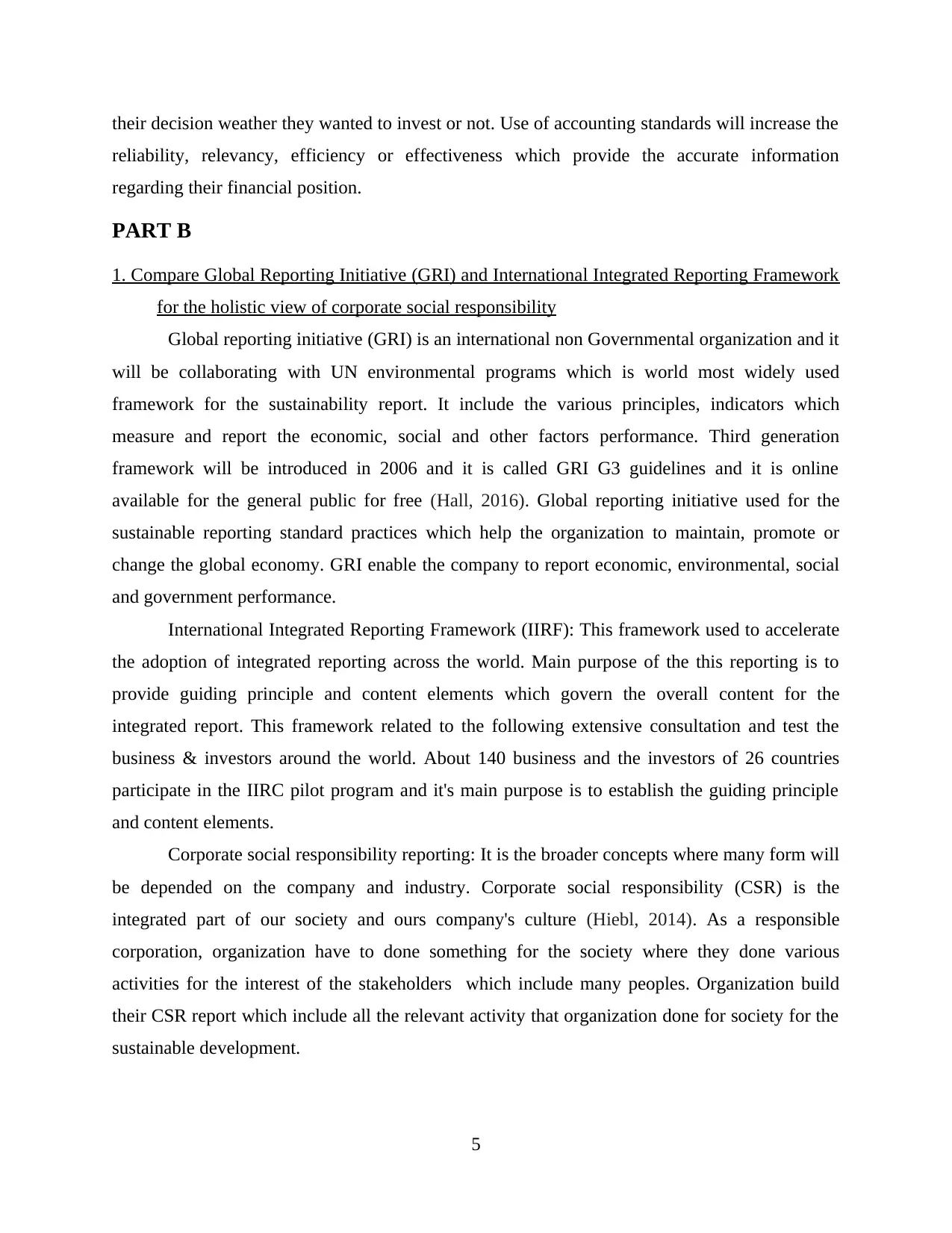
their decision weather they wanted to invest or not. Use of accounting standards will increase the
reliability, relevancy, efficiency or effectiveness which provide the accurate information
regarding their financial position.
PART B
1. Compare Global Reporting Initiative (GRI) and International Integrated Reporting Framework
for the holistic view of corporate social responsibility
Global reporting initiative (GRI) is an international non Governmental organization and it
will be collaborating with UN environmental programs which is world most widely used
framework for the sustainability report. It include the various principles, indicators which
measure and report the economic, social and other factors performance. Third generation
framework will be introduced in 2006 and it is called GRI G3 guidelines and it is online
available for the general public for free (Hall, 2016). Global reporting initiative used for the
sustainable reporting standard practices which help the organization to maintain, promote or
change the global economy. GRI enable the company to report economic, environmental, social
and government performance.
International Integrated Reporting Framework (IIRF): This framework used to accelerate
the adoption of integrated reporting across the world. Main purpose of the this reporting is to
provide guiding principle and content elements which govern the overall content for the
integrated report. This framework related to the following extensive consultation and test the
business & investors around the world. About 140 business and the investors of 26 countries
participate in the IIRC pilot program and it's main purpose is to establish the guiding principle
and content elements.
Corporate social responsibility reporting: It is the broader concepts where many form will
be depended on the company and industry. Corporate social responsibility (CSR) is the
integrated part of our society and ours company's culture (Hiebl, 2014). As a responsible
corporation, organization have to done something for the society where they done various
activities for the interest of the stakeholders which include many peoples. Organization build
their CSR report which include all the relevant activity that organization done for society for the
sustainable development.
5
reliability, relevancy, efficiency or effectiveness which provide the accurate information
regarding their financial position.
PART B
1. Compare Global Reporting Initiative (GRI) and International Integrated Reporting Framework
for the holistic view of corporate social responsibility
Global reporting initiative (GRI) is an international non Governmental organization and it
will be collaborating with UN environmental programs which is world most widely used
framework for the sustainability report. It include the various principles, indicators which
measure and report the economic, social and other factors performance. Third generation
framework will be introduced in 2006 and it is called GRI G3 guidelines and it is online
available for the general public for free (Hall, 2016). Global reporting initiative used for the
sustainable reporting standard practices which help the organization to maintain, promote or
change the global economy. GRI enable the company to report economic, environmental, social
and government performance.
International Integrated Reporting Framework (IIRF): This framework used to accelerate
the adoption of integrated reporting across the world. Main purpose of the this reporting is to
provide guiding principle and content elements which govern the overall content for the
integrated report. This framework related to the following extensive consultation and test the
business & investors around the world. About 140 business and the investors of 26 countries
participate in the IIRC pilot program and it's main purpose is to establish the guiding principle
and content elements.
Corporate social responsibility reporting: It is the broader concepts where many form will
be depended on the company and industry. Corporate social responsibility (CSR) is the
integrated part of our society and ours company's culture (Hiebl, 2014). As a responsible
corporation, organization have to done something for the society where they done various
activities for the interest of the stakeholders which include many peoples. Organization build
their CSR report which include all the relevant activity that organization done for society for the
sustainable development.
5
Paraphrase This Document
Need a fresh take? Get an instant paraphrase of this document with our AI Paraphraser
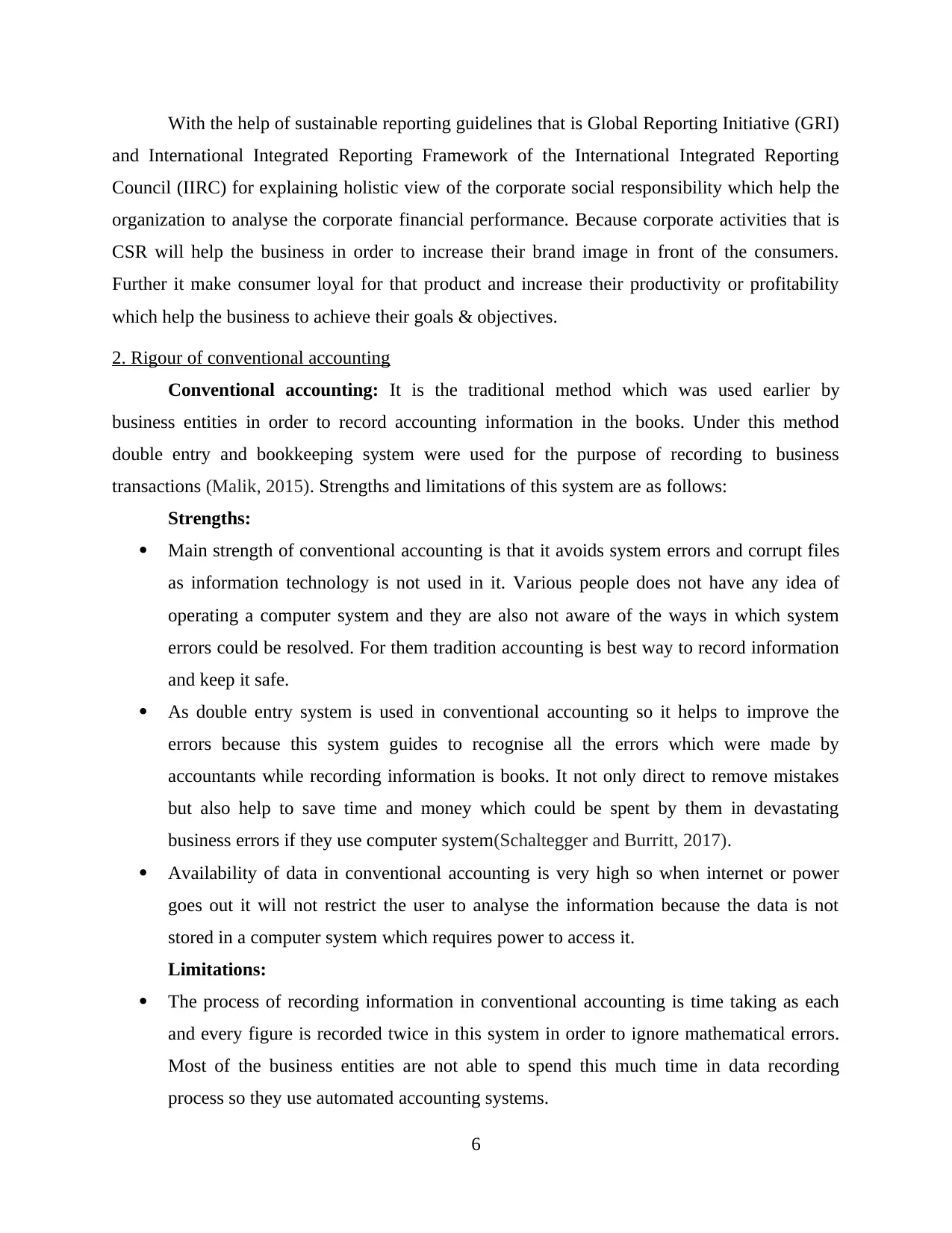
With the help of sustainable reporting guidelines that is Global Reporting Initiative (GRI)
and International Integrated Reporting Framework of the International Integrated Reporting
Council (IIRC) for explaining holistic view of the corporate social responsibility which help the
organization to analyse the corporate financial performance. Because corporate activities that is
CSR will help the business in order to increase their brand image in front of the consumers.
Further it make consumer loyal for that product and increase their productivity or profitability
which help the business to achieve their goals & objectives.
2. Rigour of conventional accounting
Conventional accounting: It is the traditional method which was used earlier by
business entities in order to record accounting information in the books. Under this method
double entry and bookkeeping system were used for the purpose of recording to business
transactions (Malik, 2015). Strengths and limitations of this system are as follows:
Strengths:
Main strength of conventional accounting is that it avoids system errors and corrupt files
as information technology is not used in it. Various people does not have any idea of
operating a computer system and they are also not aware of the ways in which system
errors could be resolved. For them tradition accounting is best way to record information
and keep it safe.
As double entry system is used in conventional accounting so it helps to improve the
errors because this system guides to recognise all the errors which were made by
accountants while recording information is books. It not only direct to remove mistakes
but also help to save time and money which could be spent by them in devastating
business errors if they use computer system(Schaltegger and Burritt, 2017).
Availability of data in conventional accounting is very high so when internet or power
goes out it will not restrict the user to analyse the information because the data is not
stored in a computer system which requires power to access it.
Limitations:
The process of recording information in conventional accounting is time taking as each
and every figure is recorded twice in this system in order to ignore mathematical errors.
Most of the business entities are not able to spend this much time in data recording
process so they use automated accounting systems.
6
and International Integrated Reporting Framework of the International Integrated Reporting
Council (IIRC) for explaining holistic view of the corporate social responsibility which help the
organization to analyse the corporate financial performance. Because corporate activities that is
CSR will help the business in order to increase their brand image in front of the consumers.
Further it make consumer loyal for that product and increase their productivity or profitability
which help the business to achieve their goals & objectives.
2. Rigour of conventional accounting
Conventional accounting: It is the traditional method which was used earlier by
business entities in order to record accounting information in the books. Under this method
double entry and bookkeeping system were used for the purpose of recording to business
transactions (Malik, 2015). Strengths and limitations of this system are as follows:
Strengths:
Main strength of conventional accounting is that it avoids system errors and corrupt files
as information technology is not used in it. Various people does not have any idea of
operating a computer system and they are also not aware of the ways in which system
errors could be resolved. For them tradition accounting is best way to record information
and keep it safe.
As double entry system is used in conventional accounting so it helps to improve the
errors because this system guides to recognise all the errors which were made by
accountants while recording information is books. It not only direct to remove mistakes
but also help to save time and money which could be spent by them in devastating
business errors if they use computer system(Schaltegger and Burritt, 2017).
Availability of data in conventional accounting is very high so when internet or power
goes out it will not restrict the user to analyse the information because the data is not
stored in a computer system which requires power to access it.
Limitations:
The process of recording information in conventional accounting is time taking as each
and every figure is recorded twice in this system in order to ignore mathematical errors.
Most of the business entities are not able to spend this much time in data recording
process so they use automated accounting systems.
6
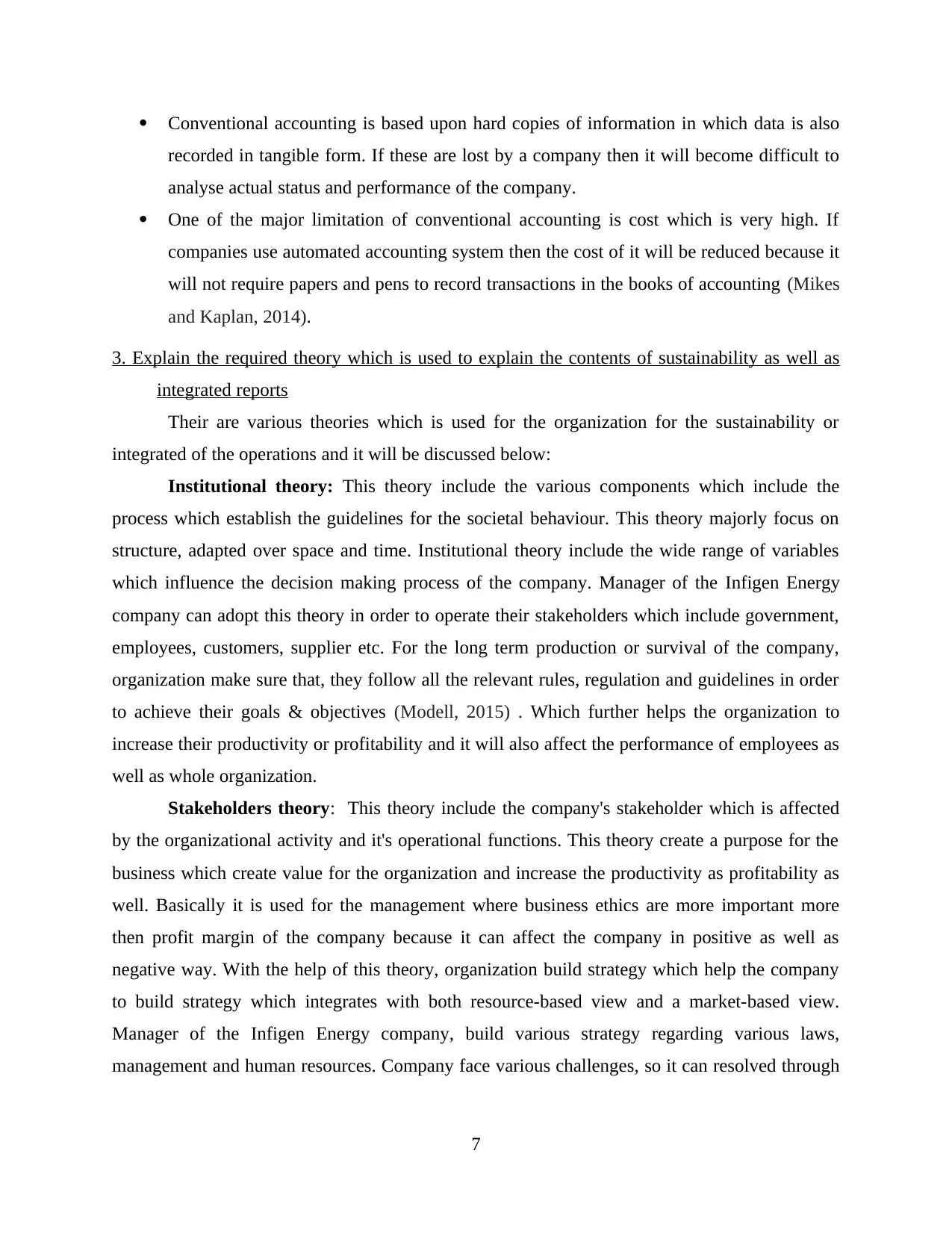
Conventional accounting is based upon hard copies of information in which data is also
recorded in tangible form. If these are lost by a company then it will become difficult to
analyse actual status and performance of the company.
One of the major limitation of conventional accounting is cost which is very high. If
companies use automated accounting system then the cost of it will be reduced because it
will not require papers and pens to record transactions in the books of accounting (Mikes
and Kaplan, 2014).
3. Explain the required theory which is used to explain the contents of sustainability as well as
integrated reports
Their are various theories which is used for the organization for the sustainability or
integrated of the operations and it will be discussed below:
Institutional theory: This theory include the various components which include the
process which establish the guidelines for the societal behaviour. This theory majorly focus on
structure, adapted over space and time. Institutional theory include the wide range of variables
which influence the decision making process of the company. Manager of the Infigen Energy
company can adopt this theory in order to operate their stakeholders which include government,
employees, customers, supplier etc. For the long term production or survival of the company,
organization make sure that, they follow all the relevant rules, regulation and guidelines in order
to achieve their goals & objectives (Modell, 2015) . Which further helps the organization to
increase their productivity or profitability and it will also affect the performance of employees as
well as whole organization.
Stakeholders theory: This theory include the company's stakeholder which is affected
by the organizational activity and it's operational functions. This theory create a purpose for the
business which create value for the organization and increase the productivity as profitability as
well. Basically it is used for the management where business ethics are more important more
then profit margin of the company because it can affect the company in positive as well as
negative way. With the help of this theory, organization build strategy which help the company
to build strategy which integrates with both resource-based view and a market-based view.
Manager of the Infigen Energy company, build various strategy regarding various laws,
management and human resources. Company face various challenges, so it can resolved through
7
recorded in tangible form. If these are lost by a company then it will become difficult to
analyse actual status and performance of the company.
One of the major limitation of conventional accounting is cost which is very high. If
companies use automated accounting system then the cost of it will be reduced because it
will not require papers and pens to record transactions in the books of accounting (Mikes
and Kaplan, 2014).
3. Explain the required theory which is used to explain the contents of sustainability as well as
integrated reports
Their are various theories which is used for the organization for the sustainability or
integrated of the operations and it will be discussed below:
Institutional theory: This theory include the various components which include the
process which establish the guidelines for the societal behaviour. This theory majorly focus on
structure, adapted over space and time. Institutional theory include the wide range of variables
which influence the decision making process of the company. Manager of the Infigen Energy
company can adopt this theory in order to operate their stakeholders which include government,
employees, customers, supplier etc. For the long term production or survival of the company,
organization make sure that, they follow all the relevant rules, regulation and guidelines in order
to achieve their goals & objectives (Modell, 2015) . Which further helps the organization to
increase their productivity or profitability and it will also affect the performance of employees as
well as whole organization.
Stakeholders theory: This theory include the company's stakeholder which is affected
by the organizational activity and it's operational functions. This theory create a purpose for the
business which create value for the organization and increase the productivity as profitability as
well. Basically it is used for the management where business ethics are more important more
then profit margin of the company because it can affect the company in positive as well as
negative way. With the help of this theory, organization build strategy which help the company
to build strategy which integrates with both resource-based view and a market-based view.
Manager of the Infigen Energy company, build various strategy regarding various laws,
management and human resources. Company face various challenges, so it can resolved through
7
⊘ This is a preview!⊘
Do you want full access?
Subscribe today to unlock all pages.

Trusted by 1+ million students worldwide
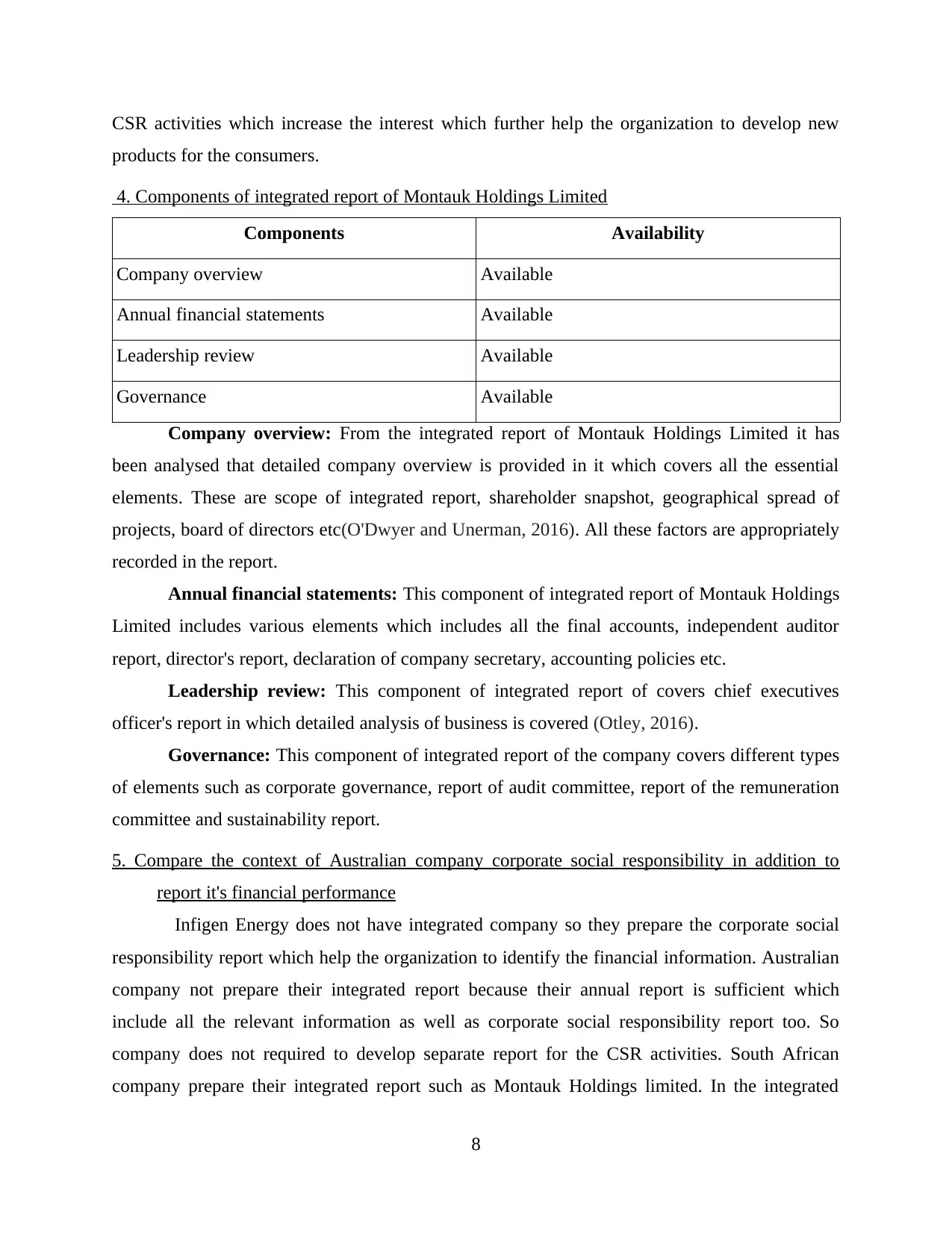
CSR activities which increase the interest which further help the organization to develop new
products for the consumers.
4. Components of integrated report of Montauk Holdings Limited
Components Availability
Company overview Available
Annual financial statements Available
Leadership review Available
Governance Available
Company overview: From the integrated report of Montauk Holdings Limited it has
been analysed that detailed company overview is provided in it which covers all the essential
elements. These are scope of integrated report, shareholder snapshot, geographical spread of
projects, board of directors etc(O'Dwyer and Unerman, 2016). All these factors are appropriately
recorded in the report.
Annual financial statements: This component of integrated report of Montauk Holdings
Limited includes various elements which includes all the final accounts, independent auditor
report, director's report, declaration of company secretary, accounting policies etc.
Leadership review: This component of integrated report of covers chief executives
officer's report in which detailed analysis of business is covered (Otley, 2016).
Governance: This component of integrated report of the company covers different types
of elements such as corporate governance, report of audit committee, report of the remuneration
committee and sustainability report.
5. Compare the context of Australian company corporate social responsibility in addition to
report it's financial performance
Infigen Energy does not have integrated company so they prepare the corporate social
responsibility report which help the organization to identify the financial information. Australian
company not prepare their integrated report because their annual report is sufficient which
include all the relevant information as well as corporate social responsibility report too. So
company does not required to develop separate report for the CSR activities. South African
company prepare their integrated report such as Montauk Holdings limited. In the integrated
8
products for the consumers.
4. Components of integrated report of Montauk Holdings Limited
Components Availability
Company overview Available
Annual financial statements Available
Leadership review Available
Governance Available
Company overview: From the integrated report of Montauk Holdings Limited it has
been analysed that detailed company overview is provided in it which covers all the essential
elements. These are scope of integrated report, shareholder snapshot, geographical spread of
projects, board of directors etc(O'Dwyer and Unerman, 2016). All these factors are appropriately
recorded in the report.
Annual financial statements: This component of integrated report of Montauk Holdings
Limited includes various elements which includes all the final accounts, independent auditor
report, director's report, declaration of company secretary, accounting policies etc.
Leadership review: This component of integrated report of covers chief executives
officer's report in which detailed analysis of business is covered (Otley, 2016).
Governance: This component of integrated report of the company covers different types
of elements such as corporate governance, report of audit committee, report of the remuneration
committee and sustainability report.
5. Compare the context of Australian company corporate social responsibility in addition to
report it's financial performance
Infigen Energy does not have integrated company so they prepare the corporate social
responsibility report which help the organization to identify the financial information. Australian
company not prepare their integrated report because their annual report is sufficient which
include all the relevant information as well as corporate social responsibility report too. So
company does not required to develop separate report for the CSR activities. South African
company prepare their integrated report such as Montauk Holdings limited. In the integrated
8
Paraphrase This Document
Need a fresh take? Get an instant paraphrase of this document with our AI Paraphraser
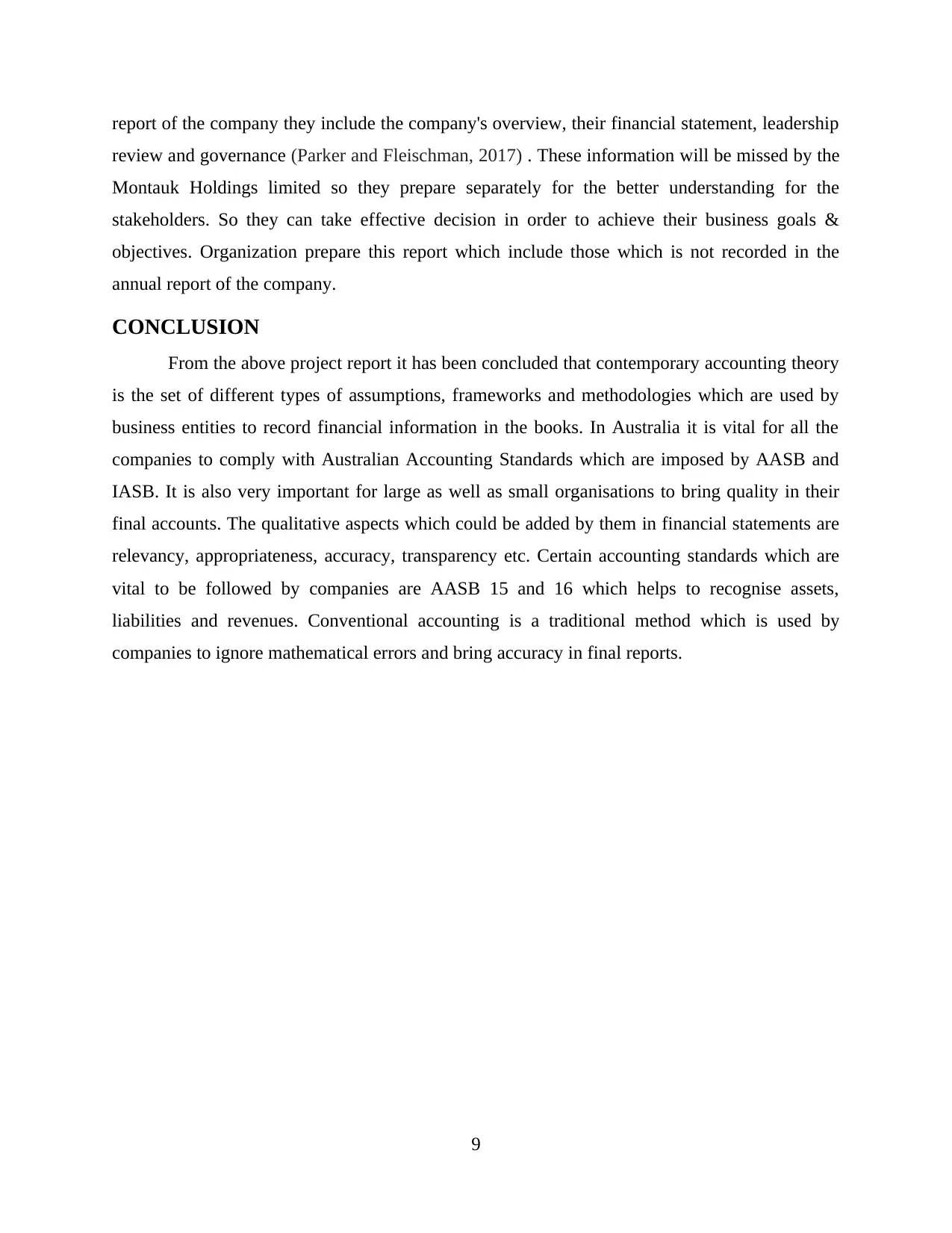
report of the company they include the company's overview, their financial statement, leadership
review and governance (Parker and Fleischman, 2017) . These information will be missed by the
Montauk Holdings limited so they prepare separately for the better understanding for the
stakeholders. So they can take effective decision in order to achieve their business goals &
objectives. Organization prepare this report which include those which is not recorded in the
annual report of the company.
CONCLUSION
From the above project report it has been concluded that contemporary accounting theory
is the set of different types of assumptions, frameworks and methodologies which are used by
business entities to record financial information in the books. In Australia it is vital for all the
companies to comply with Australian Accounting Standards which are imposed by AASB and
IASB. It is also very important for large as well as small organisations to bring quality in their
final accounts. The qualitative aspects which could be added by them in financial statements are
relevancy, appropriateness, accuracy, transparency etc. Certain accounting standards which are
vital to be followed by companies are AASB 15 and 16 which helps to recognise assets,
liabilities and revenues. Conventional accounting is a traditional method which is used by
companies to ignore mathematical errors and bring accuracy in final reports.
9
review and governance (Parker and Fleischman, 2017) . These information will be missed by the
Montauk Holdings limited so they prepare separately for the better understanding for the
stakeholders. So they can take effective decision in order to achieve their business goals &
objectives. Organization prepare this report which include those which is not recorded in the
annual report of the company.
CONCLUSION
From the above project report it has been concluded that contemporary accounting theory
is the set of different types of assumptions, frameworks and methodologies which are used by
business entities to record financial information in the books. In Australia it is vital for all the
companies to comply with Australian Accounting Standards which are imposed by AASB and
IASB. It is also very important for large as well as small organisations to bring quality in their
final accounts. The qualitative aspects which could be added by them in financial statements are
relevancy, appropriateness, accuracy, transparency etc. Certain accounting standards which are
vital to be followed by companies are AASB 15 and 16 which helps to recognise assets,
liabilities and revenues. Conventional accounting is a traditional method which is used by
companies to ignore mathematical errors and bring accuracy in final reports.
9
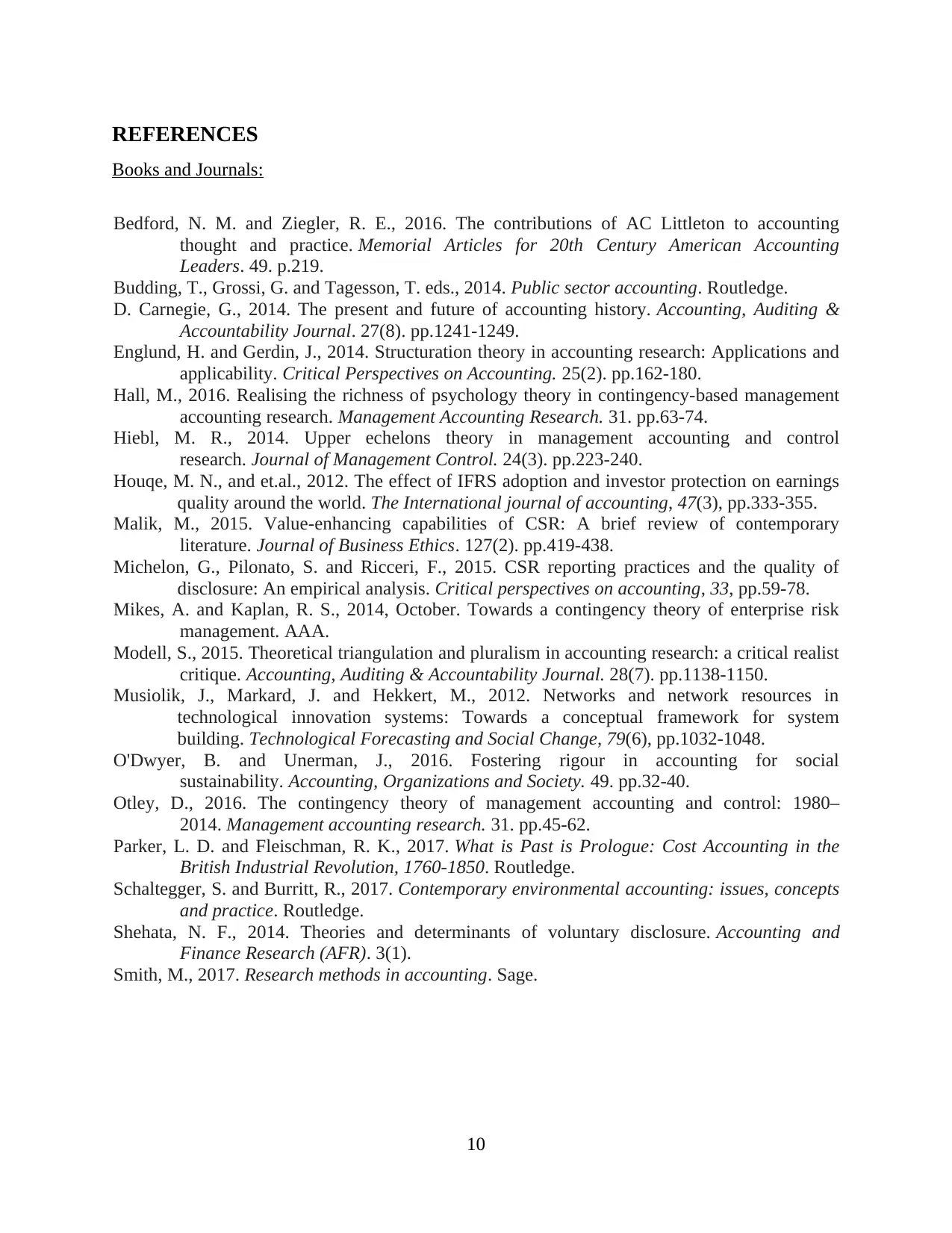
REFERENCES
Books and Journals:
Bedford, N. M. and Ziegler, R. E., 2016. The contributions of AC Littleton to accounting
thought and practice. Memorial Articles for 20th Century American Accounting
Leaders. 49. p.219.
Budding, T., Grossi, G. and Tagesson, T. eds., 2014. Public sector accounting. Routledge.
D. Carnegie, G., 2014. The present and future of accounting history. Accounting, Auditing &
Accountability Journal. 27(8). pp.1241-1249.
Englund, H. and Gerdin, J., 2014. Structuration theory in accounting research: Applications and
applicability. Critical Perspectives on Accounting. 25(2). pp.162-180.
Hall, M., 2016. Realising the richness of psychology theory in contingency-based management
accounting research. Management Accounting Research. 31. pp.63-74.
Hiebl, M. R., 2014. Upper echelons theory in management accounting and control
research. Journal of Management Control. 24(3). pp.223-240.
Houqe, M. N., and et.al., 2012. The effect of IFRS adoption and investor protection on earnings
quality around the world. The International journal of accounting, 47(3), pp.333-355.
Malik, M., 2015. Value-enhancing capabilities of CSR: A brief review of contemporary
literature. Journal of Business Ethics. 127(2). pp.419-438.
Michelon, G., Pilonato, S. and Ricceri, F., 2015. CSR reporting practices and the quality of
disclosure: An empirical analysis. Critical perspectives on accounting, 33, pp.59-78.
Mikes, A. and Kaplan, R. S., 2014, October. Towards a contingency theory of enterprise risk
management. AAA.
Modell, S., 2015. Theoretical triangulation and pluralism in accounting research: a critical realist
critique. Accounting, Auditing & Accountability Journal. 28(7). pp.1138-1150.
Musiolik, J., Markard, J. and Hekkert, M., 2012. Networks and network resources in
technological innovation systems: Towards a conceptual framework for system
building. Technological Forecasting and Social Change, 79(6), pp.1032-1048.
O'Dwyer, B. and Unerman, J., 2016. Fostering rigour in accounting for social
sustainability. Accounting, Organizations and Society. 49. pp.32-40.
Otley, D., 2016. The contingency theory of management accounting and control: 1980–
2014. Management accounting research. 31. pp.45-62.
Parker, L. D. and Fleischman, R. K., 2017. What is Past is Prologue: Cost Accounting in the
British Industrial Revolution, 1760-1850. Routledge.
Schaltegger, S. and Burritt, R., 2017. Contemporary environmental accounting: issues, concepts
and practice. Routledge.
Shehata, N. F., 2014. Theories and determinants of voluntary disclosure. Accounting and
Finance Research (AFR). 3(1).
Smith, M., 2017. Research methods in accounting. Sage.
10
Books and Journals:
Bedford, N. M. and Ziegler, R. E., 2016. The contributions of AC Littleton to accounting
thought and practice. Memorial Articles for 20th Century American Accounting
Leaders. 49. p.219.
Budding, T., Grossi, G. and Tagesson, T. eds., 2014. Public sector accounting. Routledge.
D. Carnegie, G., 2014. The present and future of accounting history. Accounting, Auditing &
Accountability Journal. 27(8). pp.1241-1249.
Englund, H. and Gerdin, J., 2014. Structuration theory in accounting research: Applications and
applicability. Critical Perspectives on Accounting. 25(2). pp.162-180.
Hall, M., 2016. Realising the richness of psychology theory in contingency-based management
accounting research. Management Accounting Research. 31. pp.63-74.
Hiebl, M. R., 2014. Upper echelons theory in management accounting and control
research. Journal of Management Control. 24(3). pp.223-240.
Houqe, M. N., and et.al., 2012. The effect of IFRS adoption and investor protection on earnings
quality around the world. The International journal of accounting, 47(3), pp.333-355.
Malik, M., 2015. Value-enhancing capabilities of CSR: A brief review of contemporary
literature. Journal of Business Ethics. 127(2). pp.419-438.
Michelon, G., Pilonato, S. and Ricceri, F., 2015. CSR reporting practices and the quality of
disclosure: An empirical analysis. Critical perspectives on accounting, 33, pp.59-78.
Mikes, A. and Kaplan, R. S., 2014, October. Towards a contingency theory of enterprise risk
management. AAA.
Modell, S., 2015. Theoretical triangulation and pluralism in accounting research: a critical realist
critique. Accounting, Auditing & Accountability Journal. 28(7). pp.1138-1150.
Musiolik, J., Markard, J. and Hekkert, M., 2012. Networks and network resources in
technological innovation systems: Towards a conceptual framework for system
building. Technological Forecasting and Social Change, 79(6), pp.1032-1048.
O'Dwyer, B. and Unerman, J., 2016. Fostering rigour in accounting for social
sustainability. Accounting, Organizations and Society. 49. pp.32-40.
Otley, D., 2016. The contingency theory of management accounting and control: 1980–
2014. Management accounting research. 31. pp.45-62.
Parker, L. D. and Fleischman, R. K., 2017. What is Past is Prologue: Cost Accounting in the
British Industrial Revolution, 1760-1850. Routledge.
Schaltegger, S. and Burritt, R., 2017. Contemporary environmental accounting: issues, concepts
and practice. Routledge.
Shehata, N. F., 2014. Theories and determinants of voluntary disclosure. Accounting and
Finance Research (AFR). 3(1).
Smith, M., 2017. Research methods in accounting. Sage.
10
⊘ This is a preview!⊘
Do you want full access?
Subscribe today to unlock all pages.

Trusted by 1+ million students worldwide
1 out of 12
Related Documents
Your All-in-One AI-Powered Toolkit for Academic Success.
+13062052269
info@desklib.com
Available 24*7 on WhatsApp / Email
![[object Object]](/_next/static/media/star-bottom.7253800d.svg)
Unlock your academic potential
Copyright © 2020–2025 A2Z Services. All Rights Reserved. Developed and managed by ZUCOL.





